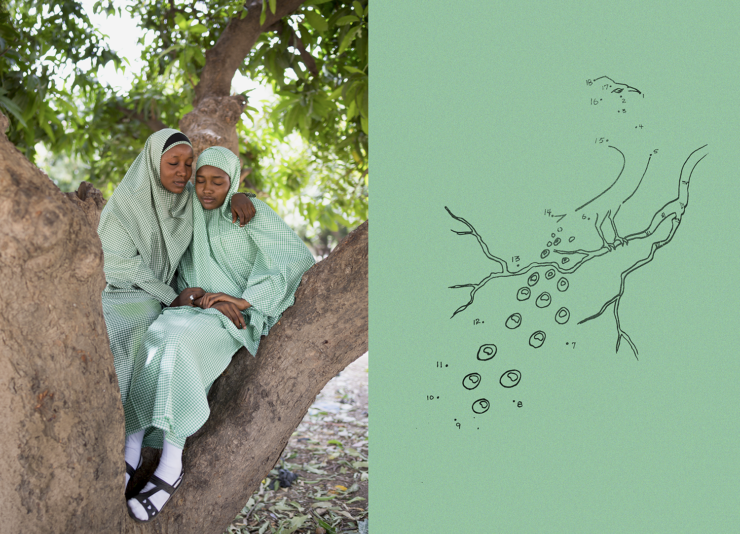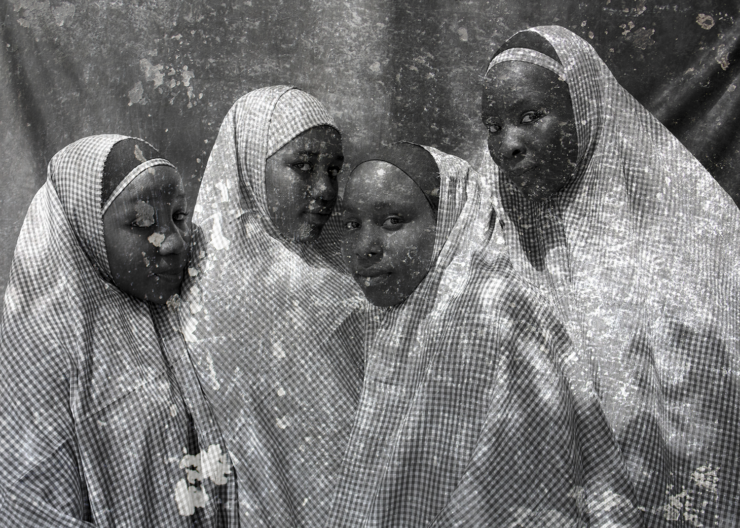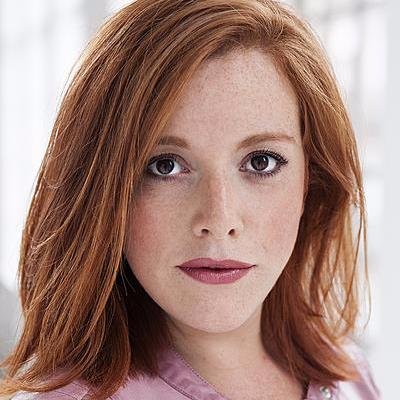
Rukkaya and Hadiza, photographed in Maiduguri, Nigeria in 2016, remember having to hide their school uniforms in plastic bags because they feared becoming a target of Boko Haram. The photo is displayed alongside a connect-the-dots illustration from the “Progressive Coloring Book” by Christopher G. Bakare, which purports to teach psychological skills to students
Nigeria is a country rich in stories and in storytelling. Nigerians have long traditions of sharing their testimonies through literature and visual communication. The work of writers like Chinua Achebe and photographers like Solomon Osagie Alonge plays a crucial role in modern African traditions and has given shape to a post-colonial aesthetic, affecting storytelling, identity, and the cultural development of liberated nations throughout the continent.
Achebe’s revolutionary way of writing, most famously in his novel “Things Fall Apart,” for instance, and his realization that the novel provided a new outlet for reorganizing African narratives changed the discourse on representation and African identity. Likewise, Alonge, the first indigenous royal court photographer in his country, reclaimed photography for the Nigerian people and helped usher in an era of Nigerians representing themselves and acting as keepers of their own history through their own narratives.
When learning about Nigeria in the news, though, we hardly ever get to see the work of Nigerian storymakers. We find rather short items and stories, mainly focused on war and militant groups viewed from a foreign lens. We learn about Boko Haram, for instance, which has caused havoc in Africa’s most populous country through its bombings, assassinations, and abductions. We learn that Boko Haram was founded in 2002 and that its official name means “People Committed to the Propagation of the Prophet’s Teachings and Jihad.” We learn that they oppose Western education and were designated a terrorist group by the U.S. in 2013.
When learning about Nigeria in the news, we hardly ever get to see the work of Nigerian storymakers
In terms of documentary photography, we often only get to see the residue of war and conflict and Nigeria is no exception. We get the constant confirmation that there is little to no valuable photography to be done beyond warfare and victimhood.
What do we learn from photojournalism about the country and the people living in it? Does it enable us to establish some rapport with the nation’s people? Or are the issues at stake simplified to such an extent that we’re not able to understand war and, most importantly, what lies underneath it? Finally, why don’t we have more Nigerian photojournalists covering these stories?
Rahima Gambo, who is originally from Yola, Nigeria, studied sociology and anthropology before becoming a documentary photographer and visual artist. She worked as a journalist after attending journalism school in New York. There, she became obsessed with photography, a medium that resonated with her as a better and more personal way to tell stories than words alone.
In 2015, Gambo began documenting through her project “Education is Forbidden” how students were experiencing the Boko Haram conflict. In the beginning, she would arrive at schools or universities during the aftermath of an attack or violent incident and document what she saw.

Rukkaya, Hadiza, Falmata, and Rashida are teenage students of Shehu Garbai Secondary School, a government school in Maiduguri, Borno State, Nigeria. Public schools were allowed to re-open in 2016 after a two-year closure enforced by the state after over 200 schoolgirls were abducted by Boko Haram
“I often had this feeling that I was arriving too late, and what I was capturing was often a residue—a quickly evaporating substance of a traumatic event I was asking my subjects to recollect,” says Gambo.
Her academic background in social sciences gave her a deep awareness of the importance of context. What happens before and after war is often just as important as the conflict itself, she realized.
“I was seeing how the culture and essence that once underpinned the identity of northeastern Nigeria was slowly being overtaken by a surge of content produced about the Boko Haram conflict,” she says. “With each article and photo, the history of the region was being rewritten as one of violence and conflict. Alternatives and histories were being erased.”
Influenced by storytellers and thinkers who have roots in the global south and strive to find a post-colonial identity, story, and language like Alonge did through photography and Achebe achieved through literature, Gambo began asking different questions.
School and universities were being attacked. But why? If you consider that a Western education system was imposed on the local people as part of a “civilizing” mission, then the purpose and structure of educational institutions as well as their colonial legacy is an important aspect of the conflict we see now.
By deeply engaging with the students as collaborators instead of subjects, Gambo moved beyond memories of traumatic events and excavated what lay underneath. She took a collaborative and playful approach with the students and engaged them in creating something as a team that spoke to their experience as a young girls trying to find themselves in that moment in time. Her intent: to tap into a collective memory of student life.
She went to schools to explore the idea of education but then the story evolved into what it is like to be out of school: at an amusement park, nature, a zoo. These spaces played a role in the girls’ collective memory.
“By working together with the students and asking them about their earliest childhood memories, their memories about stories and games passed to them in the playground,” Gambo says, “I wanted to excavate what lies beneath these students’ present memories of traumatic events they may have gone through during insurgency.”
Influenced by storytellers and thinkers who strive to find a post-colonial identity, story, and language, Gambo began asking different questions
The result: a more nuanced, personal, and multi-layered coverage of the experience of war and of what it means to go through it. Through her images and juxtaposed visuals, we are exposed to intimate moments of joy and playfulness that challenge our perceptions of victimhood and war.
We often think of stories as linear—beginning, conflict, climax, and resolution. When we ask different kinds of questions in journalism and when we keep our minds open, we discover that stories can be told in multilayered and less traditional manners. Gambo’s work covering the victims of Boko Haram is a great example of this. For instance, she makes composites of schoolbooks as a symbol of the role education has had in the context of war and conflict.
Her work does not follow the linear expectations of a photo essay. Journalists can now juxtapose elements on one “canvas,” expanding the visual language while trying to communicate complex issues.
As a storyteller, she questions her own practice, going back to the schools and questioning the educational system, talking to the students again and again, and most importantly: having them be part of the experience as much as she was. While doing so, she deconstructs her own assumptions about her subjects and story as a whole.
As a result, she makes connections between memories and playfulness and through her engagement with the girls she’s able to allow her storytelling to speak to something transcendent and open-ended, something that breaks through the superficial understanding of a victim. Her subjects are protagonists and collaborators who are able to question her assumptions. The results are complex and personal stories.
“The way we tell stories in Nigeria is not a neutral thing, it comes from a certain tradition which is very different than a Western one,” says Gambo. Achebe is one of the storytellers and thinkers who have influenced her. In his writing we see a rumination on the power that stories have to create a sense of independence, strength, and resilience.
“When documentary makers try to figure out a certain ‘truth’ or tell a story that must fit a certain platform for a certain audience, their questioning and development of that story gets affected and limited by it.”
“There are some horrific things happening in my country,” says Gambo. “I can give you the facts and figures and historical info on why this is happening, but what I am trying to do now is communicate an experience, the feelings that I have gone through while being there. What is crucial here is asking different questions and not expecting specific answers. That is when stories have an impact.”


